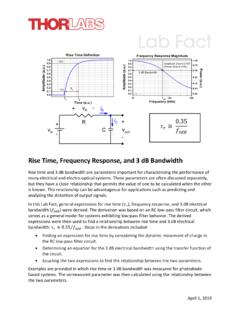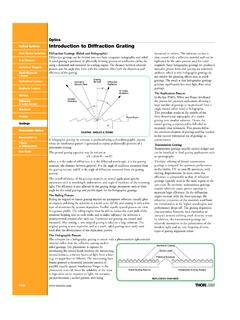Transcription of Kinesis LabView Guide - Thorlabs
1 Thorlabs 1 Kinesis in LabView Guide Kinesis LabView Guide Table of Contents Creating the Kinesis LabView Project File and Folder .. 2 Adding an .NET control to the front panel .. 5 Calling a .NET Property .. 9 Calling a .NET Method .. 12 Querying the Device Position .. 16 Controlling Speed .. 20 Homing the Motor .. 21 Moving the Motor .. 23 Creating an Iterative Movement Loop .. 26 Accessing a Property or Method with Benchtop or Rack Devices .. 30 Locating the .NET Method List .. 31 Thorlabs 2 Kinesis in LabView Guide Creating the Kinesis LabView Project File and Folder 1) On the LabView introduction screen select Blank Project 2) Save the Project in a New Folder, rename the folder to a suitable name.
2 A new folder is needed as the Kinesis .dll files need to be copied into this folder. Once the folder is created save the LabView project in this folder, again with a suitable project name. 3) The Kinesis .dll files now need to be copied to this new project folder. Navigate to the Kinesis installation folder using windows explorer. The default directory for the Thorlabs Kinesis installation is C: \Program Files\ Thorlabs \ Kinesis Thorlabs 3 Kinesis in LabView Guide 4) In this folder the easiest way to ensure all the required files are copied to the project folder is to simply select all files using Ctrl + A, then copy the files using Ctrl + C.
3 5) Now navigate back to the LabView project folder created in step (2) and paste the Kinesis files into here, using Ctrl + V. 6) Once the files have been copied, back in the LabView project window select File>New VI. This will create a new Virtual Instrument that will allow you to begin writing your own application. Thorlabs 4 Kinesis in LabView Guide 7) The new VI will open up a new Front Panel and corresponding Block Diagram window. Thorlabs 5 Kinesis in LabView Guide Adding an .NET control to the front panel LabView provides many standard controls and also has the ability to host third party controls through mechanisms such as.
4 NET. Kinesis software is exposed through .NET to allow users to incorporate hardware control through their own custom applications. Complete the following steps to add a Kinesis Motor Control to the front panel. 1) Expand the Controls palette, then select the .NET & ActiveX palette. If the Controls palette is not visible, select View/Controls Palette. 2) Select the .NET Container to attach it to the cursor, and then place the control on the front panel. Notice at this stage the container is empty. Thorlabs 6 Kinesis in LabView Guide 3) Right click on the centre of the .NET Container and select from the shortcut menu Insert.
5 NET Control . 4) From the dialog window that opens, select to manually search for the Kinesis .NET control assembly. 5) From the LabView Project folder where the controls and DLLs are copied select the file Thorlabs 7 Kinesis in LabView Guide 6) This will load all of the compatible Kinesis controls 7) From the list displayed, select the control type applicable to the hardware unit you want to load. For example, to insert a T-Cube DC Motor Control object select TCubeDCServoControl. Similarly, to insert a Benchtop Brushless DC Motor Control Object, select BenchtopBrushlessControl.
6 Note: In LabView the TCubeDCServoControl control represents the .NET control used to interface with DC servo motor controller hardware. Other hardware types have their own .NET controls as shown in the list above. Thorlabs 8 Kinesis in LabView Guide The .NET container should now contain the Kinesis motor control. Resize and position the control as required as shown. Thorlabs 9 Kinesis in LabView Guide Calling a .NET Property Before the control can run the correct serial number of the controller needs to be set to the >NET control object. Complete the following steps to set the serial number property of the Kinesis motor control object.
7 1) Select the Block Diagram window. If not visible, select Window/Show Block Diagram. 2) Display the .NET palette as shown by right clicking the TCubeDCServoControl object and selecting .NET Palette from the drop down list. 3) Select the Property Node icon to attach it to the cursor. Then drop the node onto the block diagram. 4) Wire the Kinesis control object terminal in the block diagram to the input reference connector of the property node by first clicking on the Kinesis control output connection to begin wiring. Click on the input ref connection of the property node to complete the wiring.
8 5) In wiring the property node to the Kinesis control object terminal the property node now has information available as to what properties are available. Thorlabs 10 Kinesis in LabView Guide 6) Right click the white area of the property node which by default displays the word property. In the shortcut menu choose Select Property, this will lists all of the available properties for the Kinesis Motor Control. Select the SerialNumber property from the list. 7) The property node now automatically displays the correct property node name and connectors. 8) By default the property node parameter is set to read the current value.
9 In this instance we would like to set the serial number. Right click the white area of the property node again and select Change All To Write from the shortcut menu. 9) To set the property, data needs to be connected to the input of the property node. Right click the input of the property node and select from the shortcut menu displayed Create / Control. A control, of the correct data type, is created and wired automatically. Thorlabs 11 Kinesis in LabView Guide 10) A control where the serial number of the controller can be entered will now be visible on the front panel. To go to the front panel select Window / Show Front Panel.
10 The control can be repositioned to a suitable position. The serial number of the controller should now be entered. 11) To make this serial number the default value of this control, right click the control and select Data Operations / Make Current Value Default. Thorlabs 12 Kinesis in LabView Guide Calling a .NET Method Methods of the Kinesis control object can be called within the block diagram by using a .NET Invoke Node. In this example we will call the CreateDevice method which starts communication with connected Kinesis hardware. Complete the following steps to call the CreateDevice method of the Kinesis control object.



